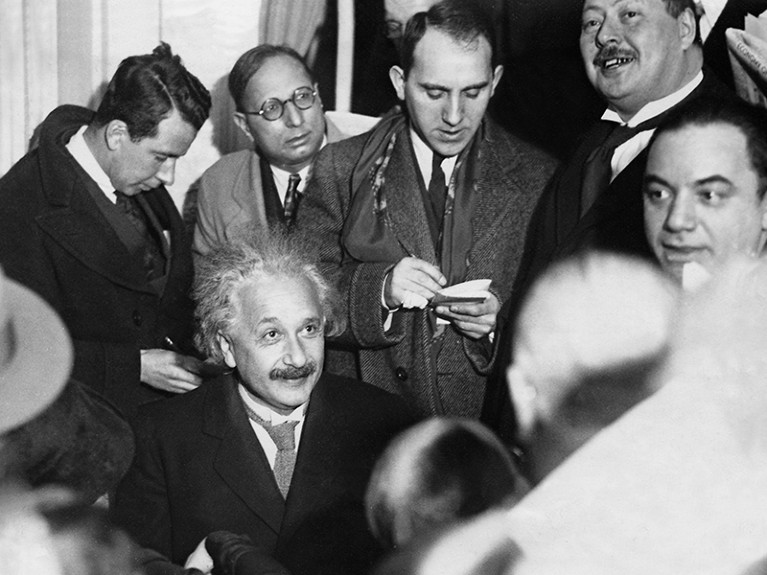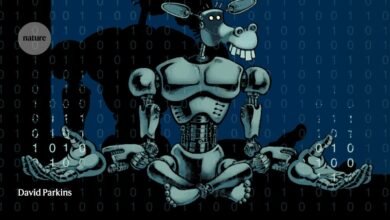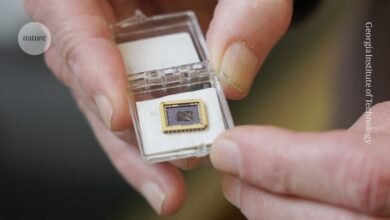How Einstein built on the past to make his breakthroughs


In 1905, German physicist Albert Einstein released four seminal physics papers, one of which won him the Nobel Prize in Physics.Credit: Sueddeutsche Zeitung Photo/Alamy
The Einsteinian Revolution: The Historical Roots of His Breakthroughs Jürgen Renn and Hanoch Gutfreund Princeton Univ. Press (2023)
German physicist Albert Einstein died in 1955, and yet he is much alive — as one of the most-famous scientists of all time, the personification of genius and the subject of a whole industry of scholarship. In The Einsteinian Revolution, two eminent experts on Einstein’s life and his theory of relativity — Israeli physicist Hanoch Gutfreund and German historian of science Jürgen Renn — offer an original and penetrating analysis of Einstein’s revolutionary contributions to physics and our view of the physical world.
Rich in biographical detail, the book is much more than another product of the Einstein industry. By setting his work in the long arc of the evolution of scientific knowledge, Gutfreund and Renn dispel the popular myth of Einstein as an unconventional scientific genius who single-handedly created modern physics from scratch — and by pure thought alone.
In 1905, his annus mirabilis, Einstein published four revolutionary papers in the journal Annals of Physics. The first explained the photoelectric effect, which established that light comes in tiny packets of energy, or photons — a work that later won him a Nobel Prize in Physics. The second concerned Brownian motion, the random movement of tiny particles, which supported the existence of atoms. The third introduced the theory of special relativity, as well as the universal speed of light. And the fourth developed the theory of the equivalence of mass and energy, expressed in the famous equation E = mc2.
Black holes, love and poetry — an artistic exploration of intimacy and adventure
These four papers don’t appear to have much in common, but, as the authors convincingly argue, they are built on the same set of underlying ideas. At the start of the twentieth century, physicists were focused on solving ‘borderline problems’, those at the junctures of mechanics, thermodynamics and electrodynamics, such as the radiation of heat and motions of microscopic particles. Einstein, more than his contemporaries did, realized that the three areas were deeply interconnected. Solutions required a holistic approach.
Einstein applied his mastery of statistical mechanics to cross boundaries between these fields. His work remained in physics, however, and he paid no attention to other areas of science, such as chemistry, astronomy or geology, as some others were doing at the time. For instance, German physicist Walther Nernst’s studies of heat straddled chemistry and physics; his compatriot, physicist Emil Wiechert blended physics and geology to deduce the layered structure of Earth.
Einstein also deployed a deductive approach. He formulated a fundamental principle and derived laws of nature from this using intuition and mathematical deduction. For example, his assumption of the constancy of the velocity of light led to relativity theory, and his conviction in the existence of atoms informed his paper on Brownian motion.
A large part of The Einsteinian Revolution is devoted to comprehending Einstein’s work in the philosophy of science. Einstein’s theories of relativity and light quanta (photons) seem to fit US philosopher Thomas Kuhn’s concept of a ‘paradigm shift’, in that these were a radical departure from existing ideas of motion and light. Yet, the authors don’t see it that way, and nor did Einstein.
Einstein typically argued that science progresses cumulatively, through steady evolution, not through revolutionary breaks with the past. He saw his theory of relativity as a natural extension of the classical physics developed by pioneers such as Italian astronomer Galileo Galilei and English physicist Isaac Newton, who both deduced the behaviour of gravity in the sixteenth and seventeenth centuries, as well as nineteenth-century physicists such as James Clerk Maxwell from Scotland and Hendrik Lorentz from the Netherlands, who also elucidated the nature of electromagnetism, light and motion.

Einstein’s work built on that of physicists like Pieter Zeeman (left) and Paul Ehrenfest (right).Credit: Archivio GBB/Alamy
The authors highlight how classical physics cannot be separated cleanly from modern Einsteinian physics. The book also includes substantial sections on Polish astronomer Nicolaus Copernicus and Galileo, who, in the sixteenth and seventeenth centuries, displaced Earth from the centre of models of the Universe, and whose methods inspired Einstein. When Einstein considered himself as standing on their shoulders, he meant that, without their contributions, he would not have formulated the theory of relativity. Gutfreund and Renn also pay much attention to the Austrian physicist–philosopher Ernst Mach, whose thoughts about matter, space and motion were important in the early phase of the Einsteinian revolution. However, whereas Mach denied the existence of atoms, Einstein took them for granted.
Although leaving room for scientific revolutions elsewhere, Gutfreund and Renn settle on describing the transformation of knowledge around Einstein’s work as a ‘Copernican process’, in which information and ideas are not rejected but reordered and reinterpreted. “The preservation of knowledge passed down from the dawn of culture is just as important as its metamorphosis through the transformation processes of scientific revolutions,” they write. In the case of Copernicus, he kept the number of celestial bodies the same but changed the architecture of the heavens by switching the positions of the Sun and Earth.
Does quantum theory imply the entire Universe is preordained?
Even Einstein’s celebrated masterpiece, his general theory of relativity in 1915, is presented as the outcome of an incremental and complex Copernican process in which the results of classical physics were reinterpreted by a shift of emphasis. Existing knowledge about gravitation was brought together with special relativity and structured in a way that made the time-honoured notion of a gravitational ‘force’ disappear.
The authors end by examining Einstein’s scientific and social legacy. Einstein adhered to the conventional doctrine that science is exclusively concerned with facts about nature and therefore irrelevant when it comes to moral values. As he put it in an address in 1939, “science can only ascertain what is, but not what should be, and outside its domain value judgments of all kinds remain necessary”.
Although Einstein emphasized that scientists must act as socially and morally responsible citizens, he also maintained that normative statements cannot be justified by science. Although this was broadly accepted at the time, it is controversial today. Indeed, referring to nothing less than “humanity’s survival within the Anthropocene”, Gutfreund and Renn challenge the doctrine. In light of global warming and other potential man-made catastrophes, they claim that “the interdependence and inseparability of scientific and moral judgments” has become all too evident. In my view, their attempt to elevate Einstein as a role model in the modern context of science and social responsibility is unconvincing.
The Einsteinian Revolution is an important and thought-provoking contribution to the scholarly literature on Einstein and his astounding scientific creativity between 1905 and 1925. Gutfreund and Renn might not have given the final answer as to why Einstein, of all people, revolutionized physics in the way that he did. But they argue in fascinating detail that, to understand his genius, one must take into account not just the earlier history of physics but also the history of knowledge more broadly. Although not always an easy read, the book will interest physicists and historians alike.
Source link





